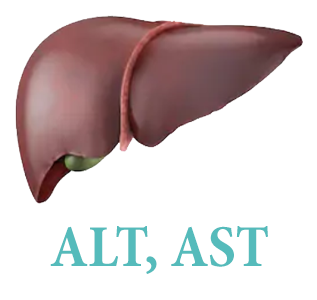Lab Test Results Interpretation Online
Complete Blood Count (CBC) Urinalysis (UA) Comprehensive Metabolic Panel (CMP) Thyroid Function Tests (TFTs) Fasting Blood Glucose TestAlanine aminotransferase (ALT), Aspartate aminotransferase (AST)
Aminotransferases (AST, ALT)
Liver blood tests help determine the health of your liver by measuring the levels of liver enzymes in your blood. Enzymes are proteins that are present throughout the body. They help to speed up routine and vital chemical reactions in the body. The liver enzymes most widely used for liver disease are the aminotransferases (aspartate aminotransferase or AST and alanine aminotransferase or ALT).
Interpret now "Complete Blood Count (CBC)"
Interpret now "Urinalysis (UA)"
Under normal circumstances, aminotransferases are found mainly in the cells of the liver, but also in other tissues, such as muscles. When the liver is damaged for any reason, ALT and AST are released into the blood stream.

Alanine transaminase (ALT) test
With the help of alanine aminotransferase (ALT, formerly known as serum glutamic-pyruvic transaminase (SGPT)) test the amount of ALT in the blood is measured. ALT is used to metabolize protein. ALT is normally found mainly in the liver. It is spilled into the bloodstream as the result of liver injury, and thus, it is a quite specific indicator of liver condition.
Aspartate aminotransferase (AST) test
Aspartate aminotransferase (AST, formerly known as serum glutamic-oxaloacetic transaminase (SGOT)) is an enzyme normally found in different tissues including heart, liver, muscles, kidney, and the brain. It is spilled into the bloodstream when any one of these tissues is damaged. An increase in AST levels may indicate, for example, a heart attacks or muscle injury. AST is not a specific indicator of liver damage as its increase can occur as a result of other injured tissues. AST prevails in the cells of the heart muscle, so its increase is a marker of myocardial destruction.
Normal Levels of AST and ALT
Normal levels of AST and ALT may slightly vary depending on the technique and protocols used by different laboratories worldwide. Typically the range for normal AST is about 5 to 40 units per liter of serum and ALT between 7 to 56 units per liter of serum.
Women tend to have slightly lower levels than men. Older adults tend to have slightly higher levels than the normal range for adults.
Elevated Levels of AST and ALT
It is important to clarify that having abnormal results on any of the liver function tests doesn’t necessarily reflect the function of the liver. Even if AST and ALT levels in blood are elevated, the liver still may function properly. Talk to your doctor about the results of your liver function test.
One of the most common causes of a mild increase in ALT and AST in asymptomatic persons is chronic alcohol consumption. Many prescription drugs also cause an increase in ALT. [1]
A very high level of ALT and AST (more than 10 times higher than normal) is usually associated with acute hepatitis. ALT and AST can also be greatly increased (sometimes more than 100 times normal) as a result of exposure to drugs or other substances that are toxic to the liver, or in conditions that cause a decrease in blood flow in the liver. [2]
+ Sources
- Yin LK, Tong KS. Elevated Alt and Ast in an Asymptomatic Person: What the primary care doctor should do?. Malays Fam Physician. 2009;4(2-3):98–99. Published 2009 Aug 31.
https://www.ncbi.nlm.nih.gov/pmc/articles/PMC4267040/ - Alanine Aminotransferase (ALT). (2020, Jan 31).
https://labtestsonline.org/tests/alanine-aminotransferase-alt - Karla Blocka. (2018, Jul 26). ALT (Alanine Aminotransferase) Test
https://www.healthline.com/health/alt